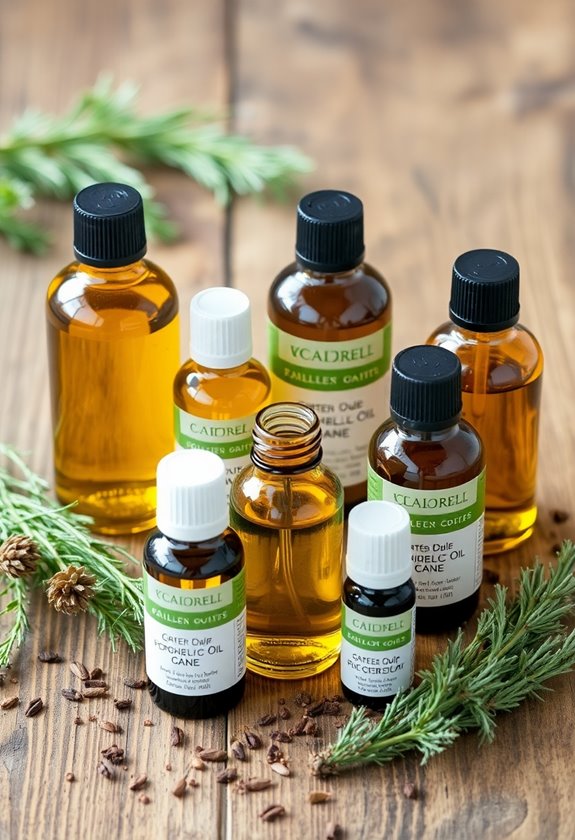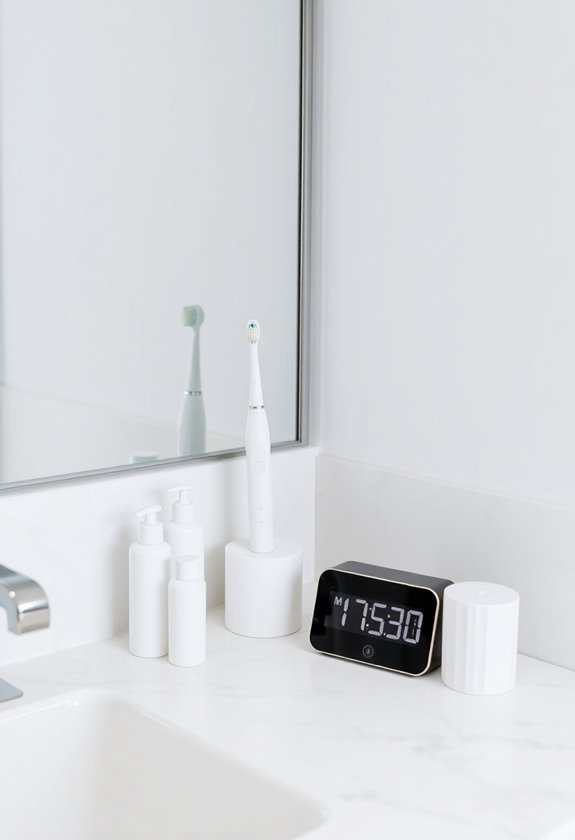To start your natural hair care journey, you'll need to first understand your hair's texture, pattern, and porosity. Begin with sulfate-free shampoo and a moisturizing conditioner that matches your hair type, washing in sections to guarantee thorough cleansing. Establish a routine that includes regular deep conditioning treatments, daily moisturizing with water-based products, and protective styling to minimize manipulation and breakage. Don't forget to use natural oils like coconut or jojoba to seal in moisture, and always detangle gently with a wide-tooth comb. Understanding these fundamentals will set you up for mastering more advanced care techniques.
Highlights
- Start by determining your hair type through texture, pattern, and porosity tests to choose appropriate products and techniques.
- Use sulfate-free shampoo and section hair into four parts while cleansing to ensure thorough cleaning without stripping natural oils.
- Deep condition hair weekly using moderate heat and a shower cap, focusing on mid-lengths and ends for optimal moisture.
- Maintain daily moisture by spraying with water, applying leave-in conditioner, and sealing with natural oils like coconut or jojoba.
- Protect hair through gentle styling, avoiding excessive manipulation, and limiting heat tool usage to prevent breakage and damage.
Understanding Your Hair Type

Every successful hair care routine starts with knowing your hair type. Your hair's unique characteristics determine which products you'll need and how you should care for your strands on a daily basis.
To identify your hair type, examine these key factors:
- Texture (fine, medium, or coarse)
- Pattern (straight, wavy, curly, or coily)
- Porosity (how well your hair absorbs and retains moisture)
- Density (how many strands you have per square inch)
- Elasticity (how much your hair can stretch without breaking)
You'll want to observe your hair when it's completely clean and product-free,
Essential Natural Hair Products

Building a natural hair care arsenal requires a few fundamental products that work with your specific hair type. You'll need to invest in these essential items to maintain healthy, vibrant hair:
- A sulfate-free shampoo that cleanses without stripping your hair's natural oils
- A moisturizing conditioner that matches your hair's porosity level
- A leave-in conditioner to provide ongoing moisture and protection
- Natural oils like coconut, jojoba, or argan oil for sealing in moisture
- A wide-tooth comb or detangling brush designed for your texture
- Satin or silk accessories (pillowcase, bonnet) to prevent friction
You'll also want to keep a spray bottle filled with water and a protein-based deep conditioner for periodic treatments. These products create the foundation for your natural hair journey.
Proper Cleansing Techniques

In accordance with healthy hair maintenance, proper cleansing techniques form the foundation of your natural hair care routine. You'll want to start by sectioning your hair into four manageable parts to guarantee thorough cleaning of your scalp and strands.
- Begin with lukewarm water to open your hair cuticles, applying shampoo primarily to your scalp using gentle, circular motions with your fingertips.
- Don't pile your hair on top of your head while washing, as this can create tangles and unnecessary friction between strands.
- Work the shampoo from roots to tips in a downward motion, being careful not to scrub the length of your hair roughly.
- Rinse thoroughly until the water runs clear, making sure you don't leave any product residue that could cause buildup.
Deep Conditioning Your Hair
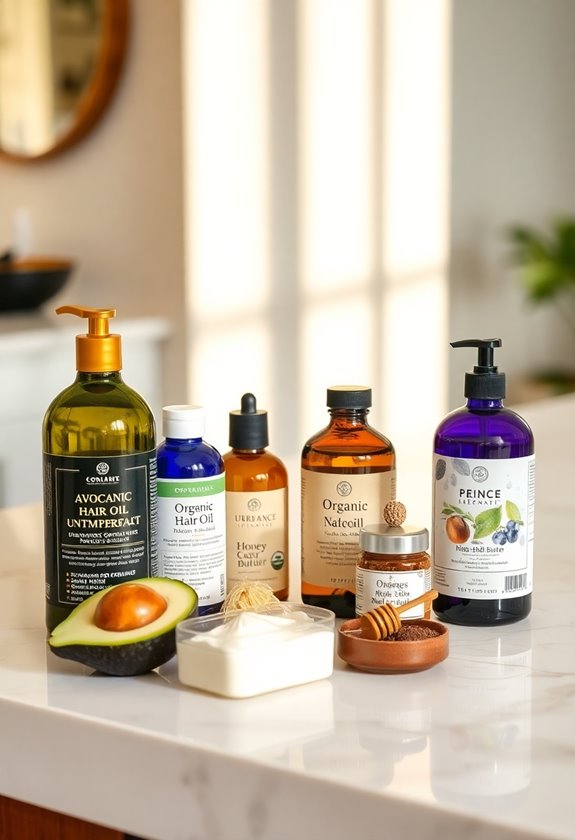
Deep conditioning stands out as one of the most essential steps in maintaining healthy natural hair. You'll need to apply your deep conditioner to clean, damp hair, making sure you're working it through from roots to ends with careful attention to damaged areas.
For the best results, you should:
- Leave the conditioner on for 15-30 minutes under a shower cap
- Use moderate heat from a hooded dryer or warm towel to enhance penetration
- Focus on your hair's mid-lengths and ends, where damage typically occurs
- Choose products with natural oils and proteins that match your hair's porosity
When rinsing, use cool water to seal your hair's cuticles, which will help lock in moisture and create a natural shine that'll last throughout the week.
Daily Moisturizing Methods
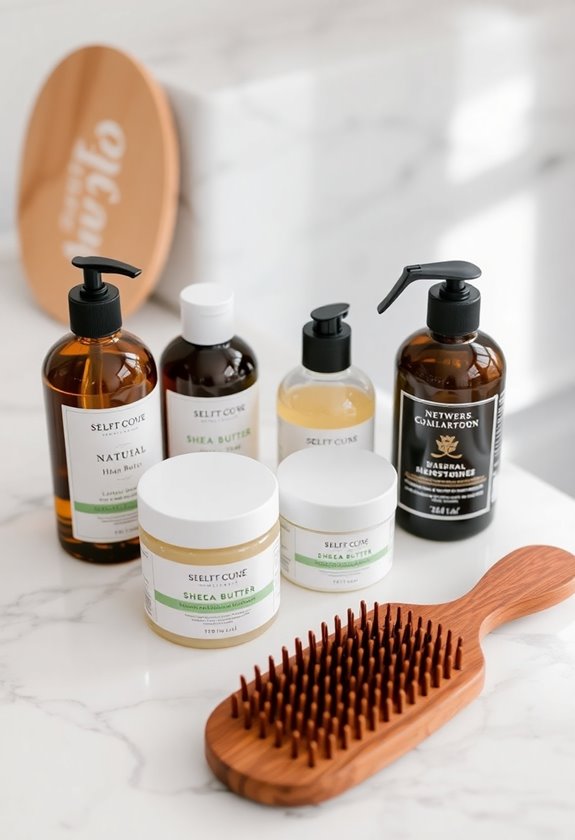
Moisture serves as the lifeblood of healthy natural hair, making daily hydration essential for maintaining its vigor and manageability. You'll need to apply moisturizer using the LOC (Liquid, Oil, Cream) method for ideal results.
Start with these key steps:
- Spray clean hair with water or a water-based leave-in conditioner
- Apply a natural oil like jojoba, coconut, or argan to seal in moisture
- Lock everything in with a moisturizing cream or butter
For best results, section your hair into manageable parts and work the products through from root to tip, ensuring even distribution. You'll want to focus extra attention on your ends, which tend to be the driest and most susceptible to breakage, while being careful not to over-saturate your roots.
Protective Styling Basics
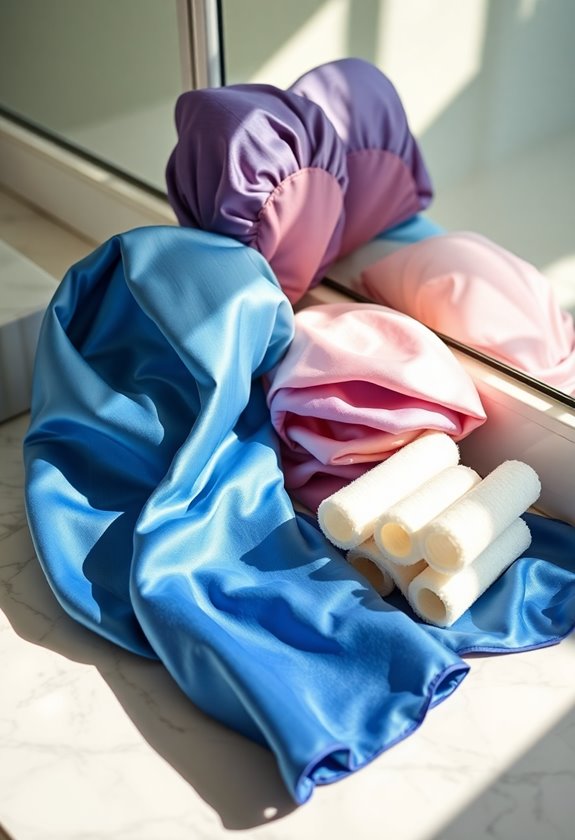
Protective styling stands as a cornerstone technique for maintaining healthy natural hair and promoting length retention. You'll want to incorporate styles like twists, braids, and updos that keep your ends tucked away from environmental damage and daily manipulation.
When choosing a protective style, you'll need to take into account these essential factors:
- Keep the style loose enough to prevent tension on your scalp
- Don't leave protective styles in for more than 6-8 weeks
- Moisturize your hair thoroughly before installing any style
- Focus on properly prepping your edges and nape area
Your protective style shouldn't cause headaches or feel too tight, as this can lead to breakage and damage. Remember to maintain your scalp's health by cleansing regularly and applying lightweight oils to prevent dryness.
Common Hair Care Mistakes
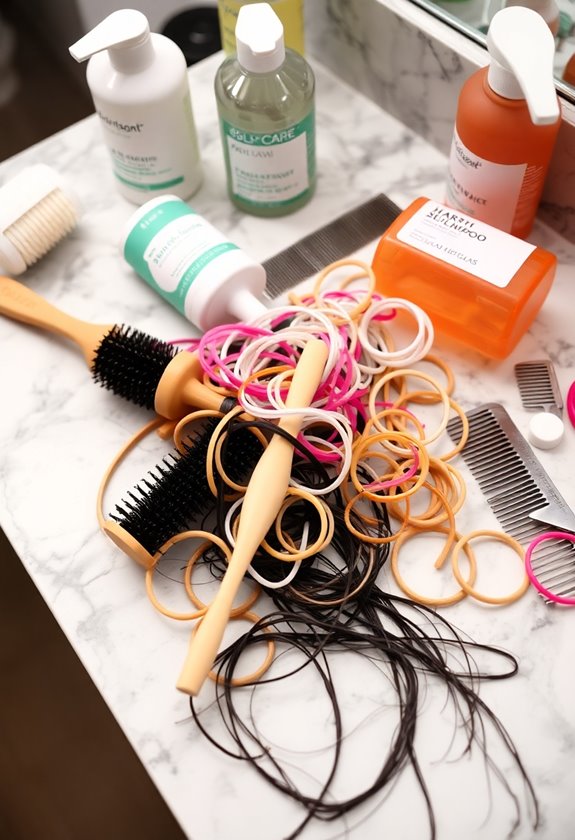
While protective styling can benefit your natural hair journey, many naturals unknowingly sabotage their hair health through common mistakes. You'll want to avoid these major pitfalls to maintain healthy hair growth and prevent unnecessary damage.
- Over-manipulating your hair through constant styling, which can lead to breakage and weakened strands
- Using heat tools too frequently or at temperatures that are too high for your hair's porosity level
- Neglecting to moisturize regularly, especially when wearing protective styles that require consistent hydration
- Leaving protective styles in for too long, which can cause matting and excessive tangles at the roots
- Using products with harsh chemicals or drying alcohols that strip your hair's natural oils
- Skipping regular deep conditioning treatments, which are essential for maintaining proper moisture balance
Frequently Asked Questions
How Often Should I Trim My Natural Hair to Prevent Split Ends?
You should trim your hair every 8-12 weeks to maintain healthy ends and prevent split ends from traveling up the hair shaft. If you're trying to grow your hair longer, you can stretch this to 12-16 weeks, but don't wait longer than that. Regular trims, removing about 1/4 to 1/2 inch each time, will help your hair look healthier and grow more effectively.
Can I Swim in Chlorinated Pools With Natural Hair?
Just as a shield protects a warrior, you'll need to protect your natural hair before swimming in chlorinated pools. You can swim safely by applying a protective leave-in conditioner and wearing a silicone swim cap to create a barrier between your hair and the harsh chemicals. After swimming, it's crucial to thoroughly rinse your hair with clean water and use a clarifying shampoo to remove any chlorine residue that might have penetrated your strands.
Will Medication or Hormone Changes Affect My Natural Hair Growth Pattern?
Yes, medications and hormonal changes can greatly affect your hair.
Does Living in Different Climates Require Adjusting My Natural Hair Routine?
Like a plant that needs different care in various environments, your natural hair will respond differently to humidity, temperature, and atmospheric conditions in different climates. You'll need to adjust your moisturizing routine in dry climates by using heavier products and deep conditioning more frequently. In humid areas, you'll want lighter products and anti-frizz solutions, while cold climates require extra protection against harsh elements and indoor heating that can cause dryness.
Can I Color My Natural Hair Without Causing Significant Damage?
You can color your natural hair safely by choosing gentle demi-permanent or plant-based dyes like henna instead of harsh permanent colors. Before coloring, deep condition your hair and perform a strand test to check for adverse reactions. If you're going lighter, consider professional help since bleaching requires technical expertise, but if you're going darker, you can often achieve good results with less damaging options at home.


